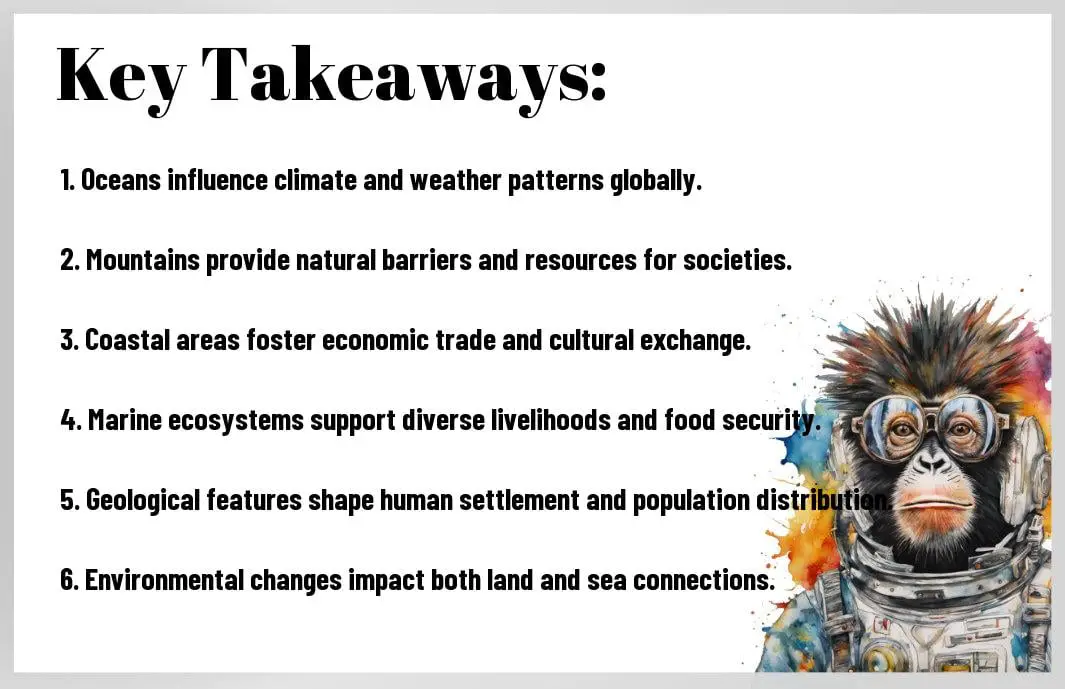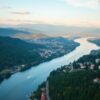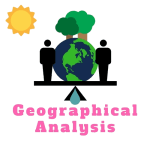Over the centuries, you may have noticed how the rugged mountains and vast oceans are not just beautiful landscapes; they play a crucial role in shaping human civilization. By understanding the interconnectedness of these natural elements, you can appreciate how they influence climate, trade, and even cultural exchange. This post examines into the intricate relationship between land and sea, revealing how these forces have molded human history and our way of life. Explore how the geographical features surrounding you have shaped the world, both past and present.

Key Takeaways:
- Geographic Influence: The proximity of mountains and oceans significantly impacts the development of human settlements, trade routes, and cultures.
- Climate Interdependence: Oceans play a crucial role in regulating climate, which in turn affects agriculture and resources found in mountainous areas.
- Biodiversity Connection: Coastal and mountainous ecosystems are interconnected, offering diverse resources that have historically supported human life and economies.
- Cultural Exchange: The mingling of land and sea has facilitated cultural exchanges, where communities adapted and evolved based on their geographic environment.
- Sustainable Practices: Understanding the link between oceans and mountains encourages sustainable practices necessary for preserving both environments in the face of modern challenges.


The Impact of Oceans on Human Civilization
Before exploring into the specifics of how oceans have shaped our societies, it is crucial to recognize their profound influences on human development. The seas and oceans are not merely vast bodies of water; they function as dynamic networks that connect continents, cultures, and economies. Understanding this interconnectedness will give you greater insight into how marine environments have played pivotal roles in the evolution of civilizations throughout history.
Historical Maritime Cultures
Historical maritime cultures have thrived on the intricate relationships they developed with the ocean. For centuries, coastal communities have relied on the sea for sustenance and economic stability. From the ancient Phoenicians, who established trade networks across the Mediterranean, to the Polynesians, who navigated vast distances across the Pacific with remarkable skill, these societies exemplified how proximity to the ocean shaped their socio-economic structures and cultural practices. You might find it fascinating that many of these maritime cultures created rich traditions tied specifically to oceanic resources and navigational prowess.
Moreover, these cultures often instilled a deep respect for the seas in their way of life. Rituals and legends surrounding the oceans would serve to reinforce community identity and foster a sense of belonging among their members. As you explore the historical significance of maritime cultures, you can draw parallels with contemporary societies that still prioritize ocean resources, revealing the enduring legacy of these ancient traditions.
Trade Routes and Economic Development
Routes established across oceans have been crucial to human civilization, acting as arteries of commerce and cultural exchange. Throughout history, trade routes like the Silk Road or the spice trade opened avenues for not just goods but also ideas and innovations. As a result, maritime trade hubs became focal points of economic development, providing communities with the resources they needed to thrive. If you examine these routes, you will notice how they contributed to the rise of powerful empires and facilitated the spread of technology and knowledge.
These maritime trade networks have led to the prosperity of cities along coastlines, creating a ripple effect in their surrounding regions. The economic opportunities provided by these trade routes allowed societies to develop more complex systems of governance and social organization. You could argue that this intricate tapestry of commerce and culture laid the groundwork for our modern global economy, illustrating how interconnected oceans and human enterprise truly are.
Another crucial aspect of the significance of trade routes is their role in fostering innovation and competition. When diverse cultures meet at trade crossroads, they exchange not just goods but also ideas and practices. You can see this in the way maritime nations often push technological advancements in shipbuilding and navigation to gain competitive advantages. This perpetual cycle of innovation drove not only economic but also cultural development, emphasizing the oceans’ role as a catalyst for human progress.
Fishing Industries and Food Security
Trade along the oceans has cultivated robust fishing industries that ensure food security for millions around the globe. For countless coastal communities, fishing is not just a livelihood but a way of life that has sustained populations for generations. As you explore the evolution of these industries, consider how traditional practices have adapted while still relying on the ocean’s bounty. The sustainability of fishing practices and resource management becomes paramount as we navigate the challenges posed by overfishing and climate change.
Furthermore, the fishing industry plays a critical role in economic stability and cultural integrity, particularly in developing regions. Cultures often revolve around the rhythm of the tides and the abundance of fish, forming deep connections to their locals’ identities. If you look at the numbers, you’ll find that countries heavily dependent on fishing often face unique challenges when it comes to balancing exploitation with environmental stewardship.
The impacts of oceanic fishing industries extend beyond immediate food security; they also include vital socio-economic dimensions. You should note that access to fresh, locally sourced seafood contributes to public health and community well-being, which is especially important as the global population continues to grow. The interconnectedness of fishing practices, cultural heritage, and environmental sustainability represents an crucial aspect of human civilization that you should consider as part of the broader ocean narrative.
Oceanic Climate Regulation
Maritime ecosystems play a vital role in regulating the Earth’s climate, making them crucial to human civilization’s survival. The oceans act as a buffer against climate extremes, absorbing excess heat and carbon dioxide generated by human activities. As you investigate into the interconnectedness of oceanic climate regulation and societal stability, you will understand better how these vast water bodies are not just passive observers but active participants in maintaining global balance.
Equally important is the role of ocean currents in transporting warm and cold water across the planet, influencing weather patterns, and enabling agriculture in far-flung areas. By regulating temperatures and weather systems, the oceans have directly impacted where human civilizations could thrive. You may find it insightful to consider how future climate change scenarios threaten this regulatory function and, by extension, the very fabric of societies that depend on predictable climates.
Security of our climate system heavily relies on healthy ocean ecosystems. If these systems are compromised, you can expect far-reaching consequences not just environmentally but socially and economically as well. The health of the oceans and climate stability are inherently linked, making it crucial for human civilization to recognize the importance of preserving marine environments for current and future generations.
The Influence of Mountains on Societies
Now, as you probe into the intricate relationship between mountains and human civilization, you may begin to recognize how these towering giants impact societies in multifaceted ways. The presence of mountains alters the landscape not just physically but also culturally, economically, and ecologically. Understanding these influences can provide a broader perspective on how civilizations have evolved and adapted through time.
Geographical Barriers and Isolation
Mountains have historically acted as geographical barriers, creating isolated regions that develop unique identities. They can hinder the movement of people, trade, and ideas, shaping cultural practices that differ significantly from those in more accessible areas. When communities are cut off by mountain ranges, they often rely on local resources and traditions, helping to foster a sense of identity and place that is distinctively their own.
This isolation can lead to a slower pace of technology and cultural exchange, resulting in societies that maintain ancient practices long after they have faded elsewhere. You may find that these mountain communities embrace unique languages, folklores, and customs, leading to a rich tapestry of cultural diversity that thrives in their isolation.
Resource Distribution and Extraction
An important aspect of mountain influence is the distribution and extraction of natural resources. Mountains are often rich in minerals, forests, and freshwater sources, making them vital for local economies. As you explore these regions, you can see how societies develop practices around the sustainable extraction of these resources, ensuring that their communities thrive while maintaining a balance with the environment.
Understanding the significance of resource distribution in mountainous regions also sheds light on the vast economic opportunities they present. For instance, mining operations can lead to wealth but also environmental challenges, prompting societies to carefully consider the implications of their choices. Your exploration of these dynamics may prompt you to reflect on the delicate balance between economic development and ecological sustainability.
Cultural Diversity and Heritage
Distribution of people across different mountain terrains fosters tremendous cultural diversity, as each community adapts to the specific challenges and opportunities their environment presents. This localized adaptation encourages unique art forms, culinary traditions, and social customs that reflect the history and values of the people. When you engage with these communities, you may uncover layers of heritage that enrich your understanding of human civilization.
Another intriguing aspect of cultural diversity found in mountainous regions is the interplay between indigenous knowledge and modern influences. The preservation of ancient traditions alongside contemporary practices can lead to vibrant cultural exchanges, allowing you to appreciate the sophistication and adaptability of human societies as they navigate complex environments.
Biodiversity and Ecosystem Services
To fully appreciate the mountains’ influence, it’s imperative to recognize their role in supporting biodiversity and providing ecosystem services. The varied climates and altitudes create rich habitats that sustain an array of plant and animal life. This biodiversity is crucial for maintaining the ecological integrity of the region and directly impacts local communities by providing resources such as food, medicine, and materials.
Geographical features of mountains also play a pivotal role in regulating water cycles and climate patterns, influencing not just local agriculture but also affecting distant regions. Your exploration of these interdependencies can enhance your understanding of how you are connected to distant ecosystems and how mountain conservation is vital for sustained human wellbeing.

Interplay Between Oceans and Mountains
Not only do oceans and mountains stand as monumental figures in our world, but they also intricately interact to influence human civilization in profound ways. The geographical juxtaposition of these two vast entities creates a dynamic interplay that shapes climate, weather, and ultimately, the way in which you live and organize your world.
Weather Patterns and Climate Influence
Any region blessed with mountains often experiences distinctive weather patterns due to their elevation and terrain. Mountains act as barriers to the prevailing winds, causing precipitation to be trapped on one side while creating arid conditions on the other. This rain shadow effect plays a crucial role in determining where cities develop, influencing the availability of fresh water and agricultural conditions. As you trace your finger over a map, you can see how these climatic distinctions have historically dictated not only where civilizations thrive but also how they adapt to their environment.
Furthermore, oceans play a significant role in sustaining climate patterns through their capacity to store and transport heat. Ocean currents regulate temperatures across continents, affecting not just local economies and livelihoods but also global weather systems. Understanding the interconnectedness of oceanic and mountainous influence enables you to appreciate the delicate balance that governs ecological health and human civilization.
Erosion and Sedimentation Processes
Processes that involve erosion and sedimentation are critical in shaping landscapes over time. Mountains are constantly worn down by the forces of nature, such as wind and rainfall, which sweep away soil and rock, transporting them towards the ocean. Meanwhile, the seas intricately participate in this cycle by not only receiving sediment but also reshaping coastal landforms. Your surroundings—be it river valleys or coastal plains—are a direct result of these ongoing processes, highlighting the ever-changing relationship between land and sea.
The sediment carried away from mountains can also enrich ocean ecosystems, forming deltas and contributing to the biodiversity of marine life. These natural cycles have a profound impact on your environment, influencing agricultural practices and resource availability in regions that rely on both oceanic and mountainous landscapes.
Ecological Connectivity and Biodiversity
Any healthy ecosystem thrives on connectivity, and the relationship between oceans and mountains is no exception. These two biomes support unique yet interdependent forms of life. Coastal habitats benefit from nutrients flowing from rivers originating in mountainous regions, supporting diverse flora and fauna. The rich biodiversity found in these transitional zones may influence your local ecosystems and the resources available to you, reinforcing the importance of conservation in both realms.
Furthermore, the distinct environments shaped by oceans and mountains serve as crucial corridors for wildlife migration. When you observe a migrating bird or fish, remember that these routes connect ecosystems across vast distances, reinforcing the biodiversity that exists in both marine and terrestrial realms. Ensuring the protection of these pathways helps maintain ecological balance and supports the natural heritage that benefits you and future generations.
Human Settlement Patterns
Weather, climate, and geographical features all significantly influence where populations settle. Historically, you may find that communities have developed in regions where rivers meet oceans, as these areas provide rich resources for fishing and agriculture. The slopes of mountains may also host thriving villages that capitalize on agriculture in suitable microclimates, demonstrating how your predecessors have adapted to the interplay between these two forces. With natural barriers presented by mountains, you might see the development of distinct cultures shaped by their immediate environment.
Biodiversity also plays a pivotal role in shaping where human settlements arise. As you initiate on a journey through various regions, consider how the availability of diverse species affects your lifestyle—from dietary habits to economic prospects. The ecological resources offered by both mountains and oceans create a tapestry of life that influences your settlement patterns and cultural practices.
The Role of Geography in Conflict and Cooperation
Unlike some natural phenomena, which tend to facilitate harmony, geography can often be a double-edged sword, shaping conflicts and driving cooperation among nations. The interaction between oceans and mountains plays a pivotal role in determining how human societies develop and interact. You should consider the profound influence that ocean currents and climate have on the economic and geopolitical relationships among countries. For instance, areas rich in marine resources can become hotspots for international rivalry and borders disputes, as nations vie for access to fish, oil, and other vital economic assets. For further insights, you can explore into the connections between those themes in Ocean Currents and Climate.
Maritime Disputes and Territorial Waters
Maritime boundaries are often a contentious issue, with countries arguing over territorial waters that can yield valuable resources. As nations extend their influence beyond their coastlines, disputes arise, leading to tensions in regions like the South China Sea, where overlapping claims make resource extraction and navigation fraught with potential conflict. You may find it interesting how such disputes are often framed in terms of national sovereignty and security, transforming bodies of water into battlegrounds of diplomacy and power struggles.
Moreover, the laws governing territorial waters, such as the United Nations Convention on the Law of the Sea (UNCLOS), offer both a framework for resolution and a catalyst for dispute. The contestation over rights to fishing grounds or exploration zones can escalate into geopolitical discord, fostering an environment where military posturing becomes a common norm among competing coastal nations.
Resource Scarcity and National Interests
National interests inevitably guide states in their approach to resource allocation and preservation, particularly when faced with scarcity. Geography plays an crucial role in determining what resources are available in your region and how accessible they are. You can see how nations with limited natural resources may feel compelled to protect their existing assets while seeking control over external resources, leading to tensions in regions like the Arctic, where melting ice caps reveal previously inaccessible oil reserves.
Understanding the consequences of resource disparity is crucial in fostering international relations. Nations experiencing resource scarcity are often thrust into a competitive stance, which can lead to militarized conflicts or diplomatic entanglements. Strategies to secure supply chains or obtain rights to extraction sites shape not only national policy but also international alliances. As the global population continues to rise, this dynamic will likely become even more pronounced.
Cooperative Conservation Efforts
Scarcity doesn’t necessarily breed conflict; it can also foster collaboration among nations, especially regarding environmental conservation. Many countries recognize that shared ecosystems and marine resources require joint stewardship to ensure sustainability. Cooperative initiatives, such as transboundary marine protected areas or joint research efforts, exemplify how geography can drive cooperation instead of confrontation, allowing you to appreciate the delicate balance between fostering development and safeguarding resources.
Conservation efforts aimed at preserving endangered species or restoring habitats often transcend political boundaries, making collaboration a necessity for ensuring ecological health. By engaging in dialogue regarding best practices and innovative conservation strategies, countries can establish trust and share knowledge that benefits all parties involved.
Disaster Response and Resilience
Maritime geography can magnify the impacts of natural disasters, but it also holds the key to collaborative resilience strategies. When you consider how oceans influence weather patterns and the frequency of storms, it becomes evident that countries must work together to develop disaster response plans. Whether it’s sharing early warning systems or coordinating evacuation efforts, pooling resources and knowledge has never been more critical in the face of escalating climate-related threats.
For instance, countries situated along shared coastlines often join forces to improve their disaster preparedness and response capabilities. Collaborative frameworks not only mitigate immediate impacts but also allow for a more resilient long-term recovery strategy. By recognizing the interconnected nature of geography, nations can foster a culture of cooperation that ultimately benefits entire regions.
Modern Implications of Ocean and Mountain Interconnectedness
Many aspects of modern life are profoundly influenced by the interconnectedness of oceans and mountains. As climate patterns shift, resource management becomes ever more critical, necessitating a holistic understanding of how these natural systems interact and shape your environment. The intricate relationships between land and sea are no longer just geological curiosities but vital frameworks for addressing the urgent challenges that face human civilization today.
Climate Change Challenges
On a global scale, climate change poses significant challenges that are deeply intertwined with both oceanic and mountainous systems. Rising sea levels, influenced by melting glaciers and polar ice, threaten coastal regions where a significant portion of the world’s population resides. You may be directly impacted by coastal erosion, flooding, and the displacement of communities, forcing a reevaluation of infrastructure and emergency preparedness. These challenges are compounded by shifting weather patterns that affect agriculture, water supply, and biodiversity, which depend heavily on the delicate balance maintained by both terrestrial and marine ecosystems.
On the other hand, mountains are critical players in climate regulation as they influence weather patterns and act as water towers for many regions. Glacial melt can temporarily enhance water supply but may lead to water scarcity in the long run. You must understand these interconnected challenges to advocate for more effective global climate policies and local adaptation strategies, ensuring that your community can respond to the pressing realities of climate change.
Sustainable Resource Management
Ocean ecosystems are rich in resources, but their sustainable management is vital for the health of both marine and terrestrial environments. You play a crucial role in promoting sustainable practices that protect these ecosystems while meeting human needs. This may involve supporting policies that regulate fishing, reduce plastic pollution, or encourage responsible tourism practices in coastal and mountain areas. It’s vital to recognize that your consumption patterns and choices directly impact these natural systems.
A sustainable approach to resource management emphasizes the need for collaborative policies that balance economic growth with environmental stewardship. By integrating knowledge from both oceanic and mountainous contexts, you can actively engage in conservation efforts that not only protect ecosystems but also safeguard the livelihoods of those who depend on these resources. In doing so, you contribute to a resilient future that respects the delicate balance of land and sea.
Technological Advances in Exploration
Management of the interconnectedness between oceans and mountains is being revolutionized by advancements in technology. These tools allow for more precise monitoring of environmental changes, helping you better understand the impacts of these shifts. With satellite imagery, remote sensing, and data analytics, you can observe patterns in climate behavior, resource distribution, and ecological health that were previously hidden or difficult to analyze.
Technological advances also enable innovative solutions aimed at sustainable development. For example, you might leverage new marine exploration technologies that allow for more effective fishery management, minimizing overfishing while still meeting market demands. Novel tools for land mapping can improve land-use planning in mountainous areas, preserving habitats while also accommodating human activities. By staying informed about these technological possibilities, you can be at the forefront of efforts to harmonize development with ecological integrity.
Urbanization and Environmental Impact
Change is an inevitable part of growth, especially as urbanization continues to expand. As cities encroach upon coastlines and mountainsides, you might witness the environmental consequences that result, including habitat loss, increased pollution, and compromised ecosystems. Urban planning must now account for not just human development but also the preservation of natural landscapes that help regulate climate and sustain biodiversity. You have a unique opportunity to advocate for sustainable urban policies that prioritize green spaces, promote public transportation, and ensure efficient land use.
Furthermore, as your own experiences within urban environments become intertwined with the ecological health of nearby oceans and mountains, you may feel a deeper responsibility toward conservation efforts. With rising urban populations, balancing development with environmental protection has never been more crucial. By engaging in community initiatives, supporting local conservation projects, or advocating for government policies that prioritize sustainability, you can make a meaningful contribution to mitigating the adverse impacts of urbanization on interconnected ecosystems.
Climate change continues to exacerbate the environmental impacts of urbanization, resulting in greater vulnerability for communities located near coastlines and mountain ranges. By staying informed and proactive, you can help create urban landscapes that are not only livable but also resilient against the challenges posed by climate change. Understanding the interconnectedness of these environments will empower you to contribute positively to the communities you inhabit.
Future Prospects for Land-Sea Interactions
After exploring the rich tapestry of interactions between land and sea, you may wonder what the future holds for these relationships. As climate change progresses and populations expand, understanding the interconnectedness of these environments will be crucial for navigating the challenges ahead. Innovations and strategies that connect coastal, marine, and terrestrial ecosystems will define your ecological, social, and economic prospects in the coming decades.
Innovations in Renewable Energy
To meet the escalating demand for clean energy, innovative solutions that harness the power of both oceans and mountains are emerging. Offshore wind farms, tidal energy systems, and hydropower infrastructures can provide sustainable energy sources while reducing reliance on fossil fuels. As you consider the role of renewable energy in your life, it is vital to appreciate how these innovations create a synergy between land and sea, benefiting coastal communities and preserving natural ecosystems.
To further enhance renewable energy efforts, significant investment in both technology and community engagement will be required. As you witness advancements in energy storage and distribution, these solutions will not only contribute to energy independence but also elevate the importance of maintaining biodiversity and ecological balance in your surroundings. It is your commitment to supporting such initiatives that can drive transformative change.
Enhancing Coastal and Mountain Resilience
On the frontline of climate change, the resilience of coastal and mountain ecosystems is paramount. As these environments face rising sea levels and increasing storm intensity, you play a critical role in advocating for strategies that bolster their resilience. By investing in natural infrastructure, such as restoring wetlands and reforesting mountains, communities can better absorb environmental shocks and maintain the delicate balance needed for healthy ecosystems.
On a broader scale, enhancing resilience will require collaborative efforts from various stakeholders—government agencies, non-profit organizations, and local communities. Understanding the unique vulnerabilities of each region will help in devising adaptive measures that not only protect human lives but also preserve biodiversity and ecological functions. Your awareness and participation in these efforts can drive meaningful change.
Understanding the dynamics of climate change impacts and the importance of resilience is imperative for thriving coastal and mountain communities. This involves recognizing the intrinsic link between ecological health and human prosperity. Amplifying community-based initiatives, disaster preparedness plans, and sustainable land-use practices will establish a robust framework for resilience, allowing both you and your community to prosper amidst the uncertainties of the future.
Predictions for Biodiversity Changes
Enhancing your understanding of how climate change will alter biodiversity is vital for both ecological and human well-being. Predictions indicate a shift in species distribution, with some marine and terrestrial organisms migrating to areas better suited to their survival. As you consider your own relationship with the environment, it is crucial to grasp how these shifts may affect local ecosystems, food security, and economies reliant on natural resources.
Enhancing conservation strategies to protect critical habitats will become increasingly important in mitigating the impacts of biodiversity loss. By fostering partnerships between governments, researchers, and community organizations, you can help raise awareness about the importance of preserving diverse ecosystems. This collaborative approach will be necessary to ensure that the benefits derived from biodiversity are available for future generations.
A critical understanding of these biodiversity changes can strengthen your commitment to environmental stewardship. As organisms adapt to shifting conditions, support for adaptive management strategies, such as habitat restoration and protection, will be fundamental to preserving ecological integrity. By being proactive, you contribute to a balanced world that respects the intricacies of both land and sea.
The Role of Policy and Governance
Coastal and mountain communities will require robust policy frameworks that facilitate sustainable land-sea interactions. As you engage with policymakers, it is crucial to advocate for integrated approaches that balance economic development with environmental conservation. The implementation of marine spatial planning and effective resource management policies can pave the way for resilient ecosystems and thriving human communities alike.
Coastal governance models that emphasize stakeholder participation will also be instrumental in shaping adaptive management strategies. These collaborative efforts can help ensure that the unique needs of each community are addressed while fostering a collective responsibility toward ecological stewardship. Your involvement in these dialogues can amplify the call for more responsible governance, helping to safeguard valuable coastal and mountain resources.
Resilience in your communities hinges on strong policy decisions that prioritize sustainable practices. By advocating for evidence-based solutions and equitable resource distribution, you can contribute to a more holistic approach to managing land-sea interactions. Your voice is key in shaping effective policies, ensuring they reflect the diverse needs of communities while protecting the ecosystems upon which we all depend.
Final Words
On the whole, understanding the interconnectedness of land and sea is necessary for grasping how oceans and mountains have shaped human civilization throughout history. As you explore the intricate relationships that bind these natural elements together, you come to realize that your environment is not just a backdrop for your existence, but a dynamic system that influences your culture, economics, and societal structures. The landscapes you inhabit, whether coastal or mountainous, have played pivotal roles in defining trade routes, fostering migration, and even influencing agricultural practices. Recognizing the impact of these natural features on human development allows you to appreciate the profound effects that geography has on your daily life.
Furthermore, as you contemplate the future challenges posed by climate change and environmental degradation, it becomes increasingly clear that an understanding of the relationship between oceans, mountains, and human civilization is necessary for sustainable development. By fostering a sense of stewardship toward both land and sea, you can contribute to a more balanced and resilient relationship with your environment. Embracing the lessons of interconnectedness can inspire you to take action in your community and advocate for policies that respect and protect these vital ecosystems. In doing so, not only do you ensure the survival of diverse habitats, but you also secure the cultural and historical narratives that continue to shape your civilization today.







